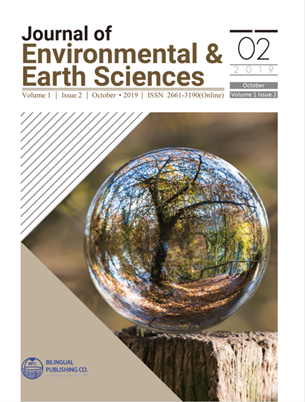
Effect of Elevated [CO2] and Nutrient Management on Grain Yield and Milling Quality of Rice in Subtropical India
DOI:
https://doi.org/10.30564/jees.v1i2.803Abstract
The climate change due to mingled effect of rising [CO2] level and temperature will influence crop production by affecting various components of the production system. In the present study, Open Top Chamber (OTC) facility has been used to realize the consequence of rising [CO2] with nutrient management on rice crop. The experiment was organized in open field and inside OTC with ambient [CO2] (400 ppm) and elevated [CO2] (25%, 50% and 75% higher than ambient) in wet season of the year 2017- 18 at Kharagpur, India. Increase in [CO2] level resulted decreasing trend in growth, yield attributes (filled grains number) and grain yield. The nutrient management with use of only chemical fertilizer at recommended dose gave highest grain yield, which was comparable with integrated management using chemical and biofertilizer. Post-harvest processing quality such as head rice percentage and the head rice yield decreased significantly with CO2 elevation. The elevated [CO2] with 25 to 75% higher than ambient, reduced the head rice percentage by 13 to 21 %. The research stated that investigations on climate change adaptations should be made to avoid the negative impact of rising [CO2] level and temperature on crop yield and processing quality.
Keywords:
Biofertilizer; Climate change; Open top chamber; Processing quality; Rice yieldReferences
[1] Ahmad, DR. MD. F. and Haseen, S., The Performance of India’s Food Grains Production: A Pre and Post Reform Assessment. International Journal of Scientific and Research Publications, 2012, 2:1-15.
[2] Baker, J. T., Allen Jr, L.H., Boote, K. J. and Pickering, N. B., Assessment of rice response to global climate change: CO2 and temperature. In: Koch GW, Mooney HA, eds. Carbon Dioxide and Terrestrial Ecosystems. San Diego, USA: Academic Press, 1996, 265-282.
[3] Cooper NTW, Siebenmorgen TJ, Counce PA, Effects of night time temperature during kernel development on rice physicochemical properties. Cereal Chem, 2008, 85: 276–282.
[4] Counce PA, Bryant RJ, Bergma CJ, Bautista RC, Wang YJ, Siebenmorgen TJ et al, Rice milling quality, grain dimensions, and starch branching as affected by high night temperatures. Cereal Chem, 2005, 82:645–648.
[5] “Crops/Regions/World list/Production Quantity (pick lists), Rice (paddy), 2014”
[6] De Costa, W.A.J.M., Weerakoon, W.M.W., Herath, H.M.L.K., Amaratunga, K.S.P. and Abeywardena, R.M.I., Physiology of yield determination of rice under elevated carbon dioxide at high temperatures in a subhumid tropical climate. Field Crops Research. 2006, 96(2-3): 336–347.
[7] Dhaliwal YS, Nagi HPS, Sidhu GS, Sekhon KS, Physicochemical, milling and cooking quality of rice as affected by sowing and transplanting dates. J Sci Food Agric, 1986, 37: 881–887.
[8] Fitzgerald, M. A. and Resurreccion, A. P.. Maintaining the yield of edible rice in a warming world. Functional Plant Biology, 2009, 36: 1037-1045.
[9] Food and Agriculture Organization, Corporate Statistical Database (FAOSTAT), 2017.
[10] Hu, S. J., Wu, J. S., Burkey, K. O. and Firestone and M. K., Plant and microbial N acquisition under elevated atmospheric CO2 in two mesocosm experiments with annual grasses. Global Change Biology, 2005, 11: 213-223.
[11] IPCC, Climate change impacts, Adaptation and Vulnerability Contribution of working group II to the fourth assessment report of the intergovernmental panel on climate change Cambridge university press Cambridge, 2007.
[12] IS 9555:1999, Rice polisher—specification (Second Revision). Indian Standard. BIS, New Delhi (110002), 1999.
[13] Kang, Y., Khan, S. and Ma, X.. Climate change impacts on crop yield, crop water productivity and food security – A review. Progress in Natural Science, 2009, 19: 665-1674. Responses to reduction in kernel number or to defoliation in collections of winter wheats. Agronomic, 2009, 5: 499–504.
[14] Leesawatwong, M., Jamjod, S., Kuo, J., Dell, B. and Rerkasem, B.. Nitrogen fertilizer increases seed protein and milling quality of rice. Cereal Chemistry, 2005, 82: 588-593.
[15] Long, S. P., Ainsworth, E. A., Rogers, A. and Ort, D. R.. Rising atmospheric carbon dioxide: plants FACE the future. Annual Review of Plant Biology. 2004, 55: 591-628.
[16] Masutomi, Y., Takahashi, K., Harasawa, H. and Matsuoka, Y.. Impact of assessment of climate change on rice production in Asia in comprehensive consideration of process/parameter uncertainty in general circulation models. Agriculture, Ecosystems and Environment, 2009, 131: 281-291.
[17] Mohammed, A. R. and Tarpley, L.. High night time temperatures affect rice productivity through altered pollen germination and spikelet fertility. Agricultural and Forest Meteorology, 2009, 149: 999-1008.
[18] Razzaque, M. A., Haque, M. M., Khaliq, Q. A., Soliman, A. R. M. and Hamid, A.. Effects of CO2 and nitrogen levels on yield and yield attributes of rice cultivars. Bangladesh Journal of Agricultural Research, 2011, 36: 213-221.
[19] Satapathy, S. S., Swain, D. K., Ghosh and M.. Effect of Climate Change on Growth, Phenology and Yield of Rice Crop Grown in Open Top Chamber in Eastern India. Global Journal of Applied Agricultural Research. ISSN 2248-9991, 2013, 3(1): 19-30.
[20] Satapathy, S. S., Swain, D. K., Bhadoria, P. B. S. and Shrivastava, S. L.. Effect of elevated carbon dioxide and nitrogen management on rice milling qualities. Eur Food Res Technol, 2014.
[21] Satake, T. and Yoshida, S.. High temperature- induced sterility in indica rices at flowering. Japanese Journal of Crop science, 1978, 47: 6-17.







 Poonam Biswal
Poonam Biswal





